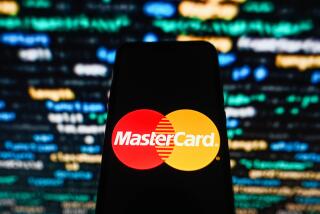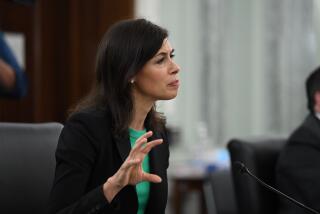How fast is your broadband? Even the feds can’t be sure
Federal authorities are taking a kind of national census of broadband Internet access speeds -- a nifty idea that could be a huge help in breaking the United States out of the high-speed slow lane.
But, as you’ll see, good luck finding a speedometer that works.
The nationwide tally of access speeds is part of a 10-year plan unveiled this week by the Federal Communications Commission to overhaul the nation’s broadband system.
High-speed Internet access is increasingly important as content grows more data-rich (movies, TV shows, etc.) and as a new era of online business, education and healthcare looms.
As it stands, U.S. Web surfers lag well behind their counterparts in South Korea, Japan, Hong Kong, Sweden and elsewhere. We rank a pitiful 18th for global broadband speeds, according to network specialist Akamai Technologies Inc.
To fix that, the FCC is proposing a slew of measures intended to wire 90% of U.S. homes with broadband lines and to boost access speeds to as much as 20 times their current rates.
“This is the great infrastructure challenge of our generation,” FCC Chairman Julius Genachowski said in a statement. “If we don’t act, our global competitiveness is at risk, as well as our role as the world’s leader in innovation.”
The plan includes requiring Internet service providers to disclose average access speeds, rather than the current practice of promising speeds “up to” a certain rate.
What many consumers now get “is often much less than the advertised peak speed,” the FCC says.
As a first step toward determining how well (or not) our broadband system works, the FCC is offering a free online test of people’s Internet connections. Such tests have been around for a while, but this is apparently the first time it’s being offered by a government agency.
All you have to do is go to Broadband.gov and click the link for “consumer broadband test.” An important component of the test is that you have to fill in your address. This will enable the FCC to pinpoint locations with particularly slow or fast access speeds (and, by extension, to hold local service providers more accountable).
But when I tested my home connection, I found that the test raised more questions than it answered.
First off, the FCC is using two different services to gauge broadband speeds. Whichever one you get is a matter of chance, although you can go back and retest with the other service.
My first test was run by a service called Ookla, which found that I was accessing the Net at a blazing-fast speed of about 18 megabits per second. That’s enough horsepower to download a whole movie in a matter of minutes.
But then I ran the test again with the FCC’s other service provider, M-Lab. Suddenly my broadband speed was a more modest 6 megabits per second, or a third of what it was supposed to have been just seconds earlier. At that rate, a movie that might have taken a few minutes to download with a faster connection might now take about a half-hour.
I ran several more tests with each service. The Ookla test consistently placed my access rate at between 17 and 20 megabits per second. The M-Lab test consistently put it at 4 to 6 megabits per second.
How to explain the discrepancy?
“We stand behind our results,” said Benjamin Lennett, a policy analyst at the New America Foundation, the Washington think tank behind M-Lab. “Our results are accurate.”
He speculated that Ookla uses a different methodology in tabulating its results, making broadband connections seem faster than they really are.
Doug Suttles, chief operating officer of Seattle-based Ookla, disputed that notion.
“We stand behind our test,” he said. “It’s very reliable and very accurate.”
Suttles speculated that M-Lab’s computers may not be up to the task of handling all the tests coming from the FCC’s Broadband.gov website. M-Lab’s Lennett disputed that notion.
So what’s the FCC have to say?
“There might be more confusion for consumers than we realized,” responded Joel Gurin, head of the agency’s Consumer and Government Affairs Bureau. “We need to make it more clear that the FCC doesn’t endorse these tests and that they’re not absolutely reliable.”
He said new caveats will be posted on the Broadband.gov site emphasizing the experimental nature of the test and explaining that results can vary -- sometimes widely.
“This is something we’ll be taking a closer look at,” Gurin said.
I called my Internet service provider, Time Warner Cable, to see what it had to say about my connection speed. While waiting on hold, I ran additional tests on a couple of other sites that don’t use either Ookla or M-Lab.
Both CNET.com and AuditMyPC.com placed my cyber-velocity at about 4 megabits per second -- in the ballpark of M-Lab’s results and just a fraction of the “up to” speed promised by Time Warner.
Finally a technician came on the line and said he could settle the matter. He instructed me to go to a website called Speakeasy.net and use its speed test.
I did. This time, my Net access clocked in at a greased-lightning level of about 20 megabits per second. The technician congratulated me for having such a fast connection.
Then I looked more closely at the Speakeasy site. It featured the Ookla test.
On the Ookla website, I learned that the company has partnerships with a wide variety of telecom companies, including Time Warner Cable, AT&T Inc. and Verizon Communications Inc.
It’s nice that the feds are finally getting serious broadband. They can start with a trustworthy speed test.
David Lazarus’ column runs Tuesdays and Fridays. He also can be seen daily on KTLA-TV Channel 5. Send your tips or feedback to david.lazarus@latimes.com







